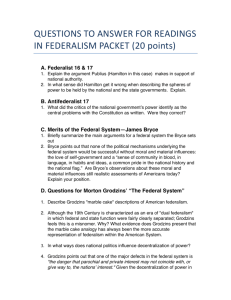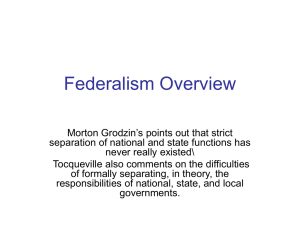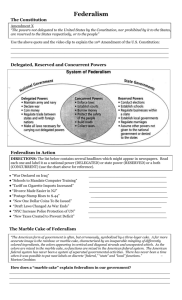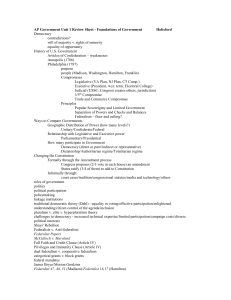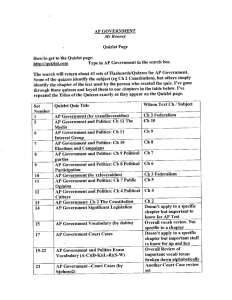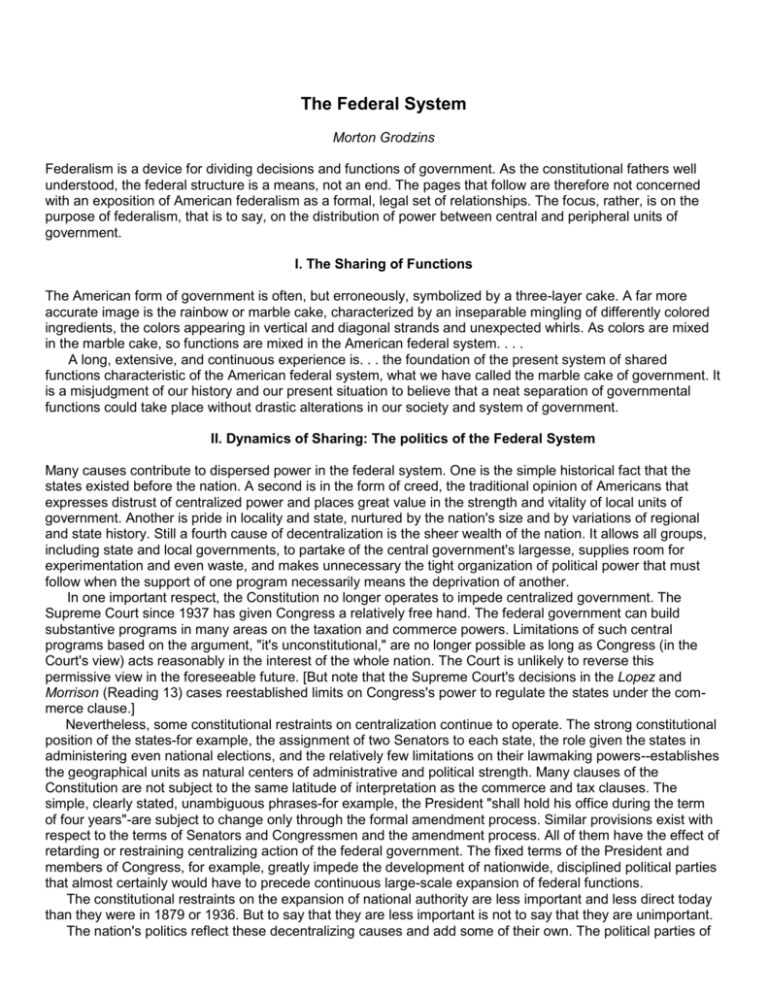
The Federal System
Morton Grodzins
Federalism is a device for dividing decisions and functions of government. As the constitutional fathers well
understood, the federal structure is a means, not an end. The pages that follow are therefore not concerned
with an exposition of American federalism as a formal, legal set of relationships. The focus, rather, is on the
purpose of federalism, that is to say, on the distribution of power between central and peripheral units of
government.
I. The Sharing of Functions
The American form of government is often, but erroneously, symbolized by a three-layer cake. A far more
accurate image is the rainbow or marble cake, characterized by an inseparable mingling of differently colored
ingredients, the colors appearing in vertical and diagonal strands and unexpected whirls. As colors are mixed
in the marble cake, so functions are mixed in the American federal system. . . .
A long, extensive, and continuous experience is. . . the foundation of the present system of shared
functions characteristic of the American federal system, what we have called the marble cake of government. It
is a misjudgment of our history and our present situation to believe that a neat separation of governmental
functions could take place without drastic alterations in our society and system of government.
II. Dynamics of Sharing: The politics of the Federal System
Many causes contribute to dispersed power in the federal system. One is the simple historical fact that the
states existed before the nation. A second is in the form of creed, the traditional opinion of Americans that
expresses distrust of centralized power and places great value in the strength and vitality of local units of
government. Another is pride in locality and state, nurtured by the nation's size and by variations of regional
and state history. Still a fourth cause of decentralization is the sheer wealth of the nation. It allows all groups,
including state and local governments, to partake of the central government's largesse, supplies room for
experimentation and even waste, and makes unnecessary the tight organization of political power that must
follow when the support of one program necessarily means the deprivation of another.
In one important respect, the Constitution no longer operates to impede centralized government. The
Supreme Court since 1937 has given Congress a relatively free hand. The federal government can build
substantive programs in many areas on the taxation and commerce powers. Limitations of such central
programs based on the argument, "it's unconstitutional," are no longer possible as long as Congress (in the
Court's view) acts reasonably in the interest of the whole nation. The Court is unlikely to reverse this
permissive view in the foreseeable future. [But note that the Supreme Court's decisions in the Lopez and
Morrison (Reading 13) cases reestablished limits on Congress's power to regulate the states under the commerce clause.]
Nevertheless, some constitutional restraints on centralization continue to operate. The strong constitutional
position of the states-for example, the assignment of two Senators to each state, the role given the states in
administering even national elections, and the relatively few limitations on their lawmaking powers--establishes
the geographical units as natural centers of administrative and political strength. Many clauses of the
Constitution are not subject to the same latitude of interpretation as the commerce and tax clauses. The
simple, clearly stated, unambiguous phrases-for example, the President "shall hold his office during the term
of four years"-are subject to change only through the formal amendment process. Similar provisions exist with
respect to the terms of Senators and Congressmen and the amendment process. All of them have the effect of
retarding or restraining centralizing action of the federal government. The fixed terms of the President and
members of Congress, for example, greatly impede the development of nationwide, disciplined political parties
that almost certainly would have to precede continuous large-scale expansion of federal functions.
The constitutional restraints on the expansion of national authority are less important and less direct today
than they were in 1879 or 1936. But to say that they are less important is not to say that they are unimportant.
The nation's politics reflect these decentralizing causes and add some of their own. The political parties of
the United States are unique. They seldom perform the function that parties traditionally perform in other
countries, the function of gathering together diverse strands of power and welding them into one. Except during
the period of nominating and electing a President and for the essential but non-substantive business of
organizing the houses of Congress, the American parties rarely coalesce power at all. Characteristically they
do the reverse, serving as a canopy under which special and local interests are represented with little regard
for anything that can be called a party program. National leaders are elected on a party ticket, but in Congress
they must seek cross-party support if their leadership is to be effective. It is a rare President during rare
periods who can produce legislation without facing the defection of substantial numbers of his own party.
(Wilson could do this in the first session of the Sixty-Third Congress; but Franklin D. Roosevelt could not, even
during the famous hundred days of 1933.) Presidents whose parties form the majority of the Congressional
houses must still count heavily on support from the other party.
The parties provide the pivot on which the entire governmental system swings. Party operations, first of all,
produce in legislation the basic division of functions between the federal government, on the one hand, and
state and local governments, on the other. . . .
The party system compels administrators to take a political role. This is a third way in which the parties
function to decentralize the American system. The administrator must play politics for the same reason that the
politician is able to play in administration: the parties are without program and without discipline.
In response to the unprotected position in which the party situation places him, the administrator is forced
to seek support where he can find it. One ever present task is to nurse the Congress of the United States, that
crucial constituency which ultimately controls his agency's budget and program. From the administrator's view,
a sympathetic consideration of Congressional request (if not downright submission to them) is the surest way
to build the political support without which the administrative job could not continue. Even the completely taskoriented administrator must be sensitive to the need for Congressional support and to the relationship betWeen
case work requests, on one side, and budgetary and legislative support, on the other. "You do a good job
handling the personal problems and requests of a Congressman," a White House officer said, "and you have
an easier time convincing him to back your program." Thus there is an important link between the nursing of
Congressional requests, requests that largely concern local matters, and the most comprehensive national
programs. The administrator must accommodate to the former as a price of gaining support for the latter.
One result of administrative politics is that the administrative agency may become the captive of the
nationwide interest group it serves or presumably regulates. In such cases no government may come out with
effective authority: the winners are the interest groups themselves. But in a very large number of cases, states
and localities also win influence. The politics of administration is a process of making
peace with legislators who for the most part consider themselves the guardians of local interests. The political
role of administrators therefore contributes to the power of states and localities in national programs.
Finally, the way the party system operates gives American politics their overall distinctive tone. The lack of
party discipline produces an openness in the system that allows individuals, groups, and institutions (including
state and local governments) to attempt to influence national policy at every step of the legislativeadministrative process. This is the "multiple-crack" attribute of the American government. "Crack" has tWo
meanings. It means not only many fissures or access points; it also means, less statically, opportunities for
wallops or smacks at government.
If the parties were more disciplined, the result would not be a cessation of the process by which individuals
and groups impinge themselves upon the central government. But the present state of the parties clearly
allows for a far greater operation of the multiple crack than would be possible under the conditions of
centralized party control. American interest groups exploit literally uncountable access points in the legislativeadministrative process. If legislative lobbying, from committee stages to the conference committee, does not
produce results, a Cabinet secretary is called. His immediate associates are petitioned. Bureau chiefs and their
aides are hit. Field officers are put under pressure. Campaigns are instituted by which friends of the agency
apply a secondary influence on behalf of the interested party. A conference with the President may be urged.
To these multiple points for bringing influence must be added the multiple voices of the influencers.
Consider, for example, those in a small town who wish to have a federal action taken. The easy merging of
public and private interest at the local level means that the influence attempt is made in the name of the whole
community, thus removing it from political partisanship. The Rotary Club as well as the City Council, the
Chamber of Commerce and the mayor, eminent citizens and political bosses--all are readily enlisted. If a
conference in a Senator's office will expedite matters, someone on the local scene can be found to make such
a conference possible and effective. If technical information is needed, technicians will supply it. State or
national professional organizations of local officials, individual Congressmen and Senators, and not
infrequently whole state delegations will make the local cause their own. Federal field officers, who service
localities, often assume local views. So may elected and appointed state officers. Friendships are exploited,
and political mortgages called due. Under these circumstances, national policies are molded by local action.
In summary, then, the party system functions to devolve power. The American parties, unlike any other, are
highly responsive when directives move from the bottom to the top, highly unresponsive from top to bottom.
Congressmen and Senators can rarely ignore concerted demands from their home constituencies; but no party
leader can expect the same kind of response from those below, whether he be a President asking for
Congressional support or a Congressman seeking aid from local or state leaders. Any tightening of the party
apparatus would have the effect of strengthening the central government. The four characteristics of the
system, discussed above, would become less important. If control from the top were strictly applied, these
hallmarks of American decentralization might entirely disappear. To be specific, if disciplined and programoriented parties were achieved: (1) It would make far less likely legislation that takes heavily into account the
desires and prejudices of the highly decentralized power groups and institutions of the country, including the
state and local governments. (2) It would to a large extent prevent legislators, individually and collectively, from
intruding themselves on behalf of non-national interests in national administrative programs. (3) It would put an
end to the administrator's search for his own political support, a search that often results in fostering state,
local, and other non-national powers. (4) It would dampen the process by which individuals and groups,
including state and local political leaders, take advantage of multiple cracks to steer national legislation and
administration in ways congenial to them and the institutions they represent.
Alterations of this sort could only accompany basic changes in the organization and style of politics which,
in turn, presuppose fundamental changes at the parties' social base. The sharing of functions is, in fact, the
sharing of power. To end this sharing process would mean the destruction of whatever measure of
decentralization exists in the United States today. . . .
Grodzins, M. (2004), The federal system P. Woll (Ed.), American Government Readings and Cases (pp. 7478). New York: Pearson Longman.
___________________________________________________________
Questions for Morton Grodzins’ “The Federal System” (answer on
another sheet of paper)
1. Describe Grodzins "marble cake" descriptions of American federalism.
2. Although the 19th Century is characterized as an era of "dual federalism" in which federal and
state function were fairly clearly separated; Grodzins feels this is a misnomer. Why?
3. What evidence does Grodzins present that the marble cake analogy has always been the more
accurate representation of federalism within the American System.
4. In what ways does national politics influence decentralization of
power?
5. Grodzins points out that one of the major defects in the federal
system is "the danger that parochial and private interest may not
coincide with, or give way to, the nations’ interest." Given the
decentralization of power in our political system, and the general
dispersion of power at the national level (the separation of powers,
powerful congressional committees, independent administrative
agencies, and so on) how does Grodzins feel the centrifugal force
of domestic politics need to be balanced?
6. Using the text as a source, what might be another good title for this
reading?

